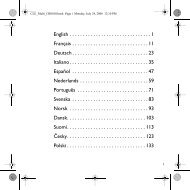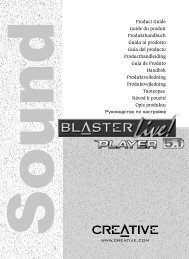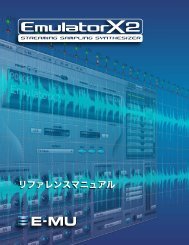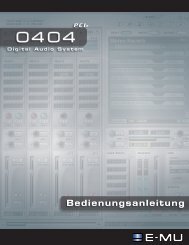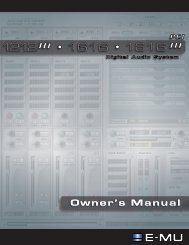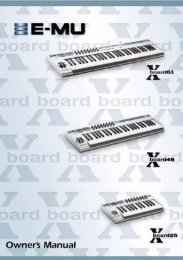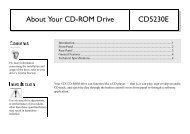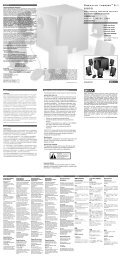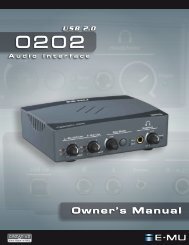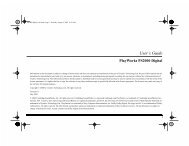You also want an ePaper? Increase the reach of your titles
YUMPU automatically turns print PDFs into web optimized ePapers that Google loves.
4 - The PatchMix DSP Mixer<br />
Mixer Strip Creation<br />
3. Choose one of the Send Outputs. Click on a destination to select it.<br />
4. Choose one of the Return Inputs. Click on a source to select it.<br />
5. Click OK to select the Send and Return or Cancel to cancel the operation.<br />
To Delete Effects from an Insert:<br />
1. Right-Click over the Insert Effect you wish to delete. A yellow line around the insert<br />
location indicates that it is selected. A pop-up dialog box appears.<br />
2. Select “Delete Insert” to remove the selected insert or select “Delete All Inserts” to<br />
remove all inserts.<br />
3. The effect(s) are deleted from the insert chain.<br />
To Bypass an Insert:<br />
Inserts can be bypassed if you want to temporarily hear the audio without the effect or<br />
insert. Bypass can also be used to turn off a Send Insert.<br />
Method #1<br />
1. Click on the Effect (in the Insert section) and select FX in the TV display.<br />
2. Click the Bypass button.<br />
Method #2<br />
1. Right-Click over the Effect you want to bypass (in the Insert section). A pop-up<br />
dialog box appears.<br />
2. Select “Bypass Insert” from the list of options.<br />
To Solo an Insert:<br />
Inserts can also be soloed. Solo bypasses all the other inserts in the strip and allows you<br />
to hear only the soloed effect. This feature is very useful when adjusting the effect<br />
parameters.<br />
Method #1<br />
1. Click on the Effect (in the Insert section) and select FX in the TV display.<br />
2. Click the Solo button.<br />
Method #2<br />
1. Right-Click over the Effect you want to Solo (in the Insert section). A pop-up dialog<br />
box appears.<br />
2. Select “Solo Insert” from the list of options.<br />
Meter Inserts<br />
Keeping track of signal levels is important in any audio system, be it analog or digital.<br />
You want to keep the signal levels running as close to maximum in order to achieve high<br />
resolution and low noise. On the other hand, you don’t want the signal level so high as<br />
to cause clipping. To help you maintain optimum signal levels, we have included Peak<br />
Level Meters, which can be dropped into any insert location.<br />
The insert meters are of the “peak hold” type. The topmost bar in the meter holds its<br />
highest level for a second to let you see transients that would otherwise be too quick for<br />
the eye. A numeric readout above the meter shows the peak-hold level in dB.<br />
The peak meters are also color-coded to indicate the signal strength. The chart below<br />
outlines the meanings of the colors. Avoid lighting the topmost red bar, as this indicates<br />
distortion of the signal. Click on the clip indicator to turn it off.<br />
f Tip: Select the Plug-in<br />
and press the Delete key<br />
to delete the plug-in from<br />
the strip.<br />
20 <strong>Creative</strong> Professional




